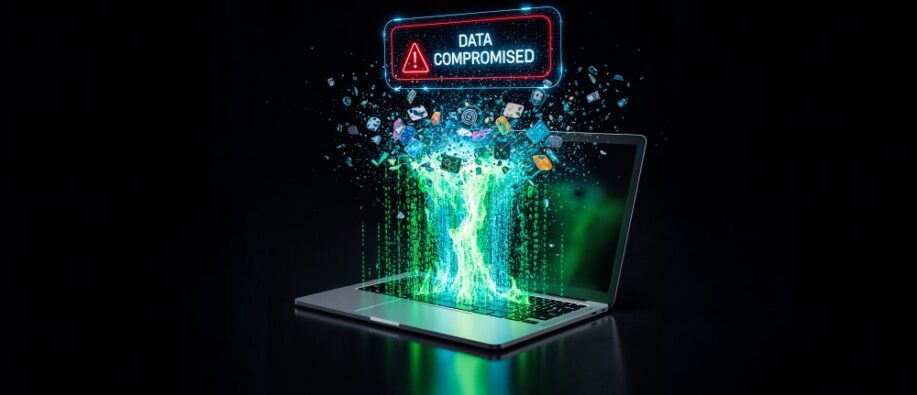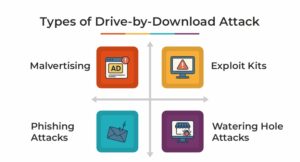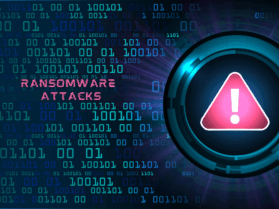Suppose you are conducting research and need to dive deep into a specific topic. You are looking at 10 tabs; find the information you need, then click on one site that provides an entry point for malware on the device.
Malicious software is installed on your website; your important information is stolen and is exposed to threats! Wait! There’s always a solution.
This blog guides you through the entire context of drive-by-download attacks. Alongside, its types and preventive measures so you don’t fall victim to the same.
Without any further ado, let’s get started.
What is Drive-by-Download Attack?
Drive-by-download is basically a form of cyberattack wherein a malicious code is downloaded on your computer or device without permission from the user. It opens the way to different types of malwares such as trojans, ransomware, and more. One thing to note is that these security issues can take place on any app, operating system, or web browser with security issues, failed updates, outdated software, and others.
Users don’t need to click on any link; the drive-by-download attack occurs if you simply visit a web page with a malicious code. You don’t even know if malware has been installed on your device; you notice it when it starts causing damage to the system.
Drive by download attacks are meant to harm the website, steal important information, or cause damage to the device.
How Drive-by-Download Works?
A drive-by download occurs when malicious code is installed on a user's device without the user’s knowledge. It may be done by deceiving users into downloading malware by clicking on and visiting websites or by opening pop-ups, mainly through active attacks. The second way is to exploit the browser when a user opens a web page, called a passive attack.
In active attacks, the user is involved; in passive attacks, the user is not, and they may go undetected whilst seeking software weaknesses to exploit. Both enable unauthorized attacks against compromised computers and data.
Different Types of Drive-by-Download Attack
Malvertising: Here, hackers insert malicious code in ads placed on websites that are trusted. When you click on these ads, malware is automatically installed on your device.
Exploit Kits: A Malicious collection of code usually used by hackers to benefit from the security flaws in the user’s device.
Phishing Attacks: In this case, fraudsters deceive users by clicking a false link in an email or message, then downloading a harmful file.
Watering Hole Attacks: Attackers implant malware on websites (usually used by a specific target group).
Keep reading below to read the tips to stay safe from the above incidents.
What Preventive Measures Should Website Owners Follow?
There are several ways to keep the website secure from drive-by download attacks. It’s important to consider them all, as neglecting any one of them can impact your website — and, in turn, your business.
- Always ensure that you update all the extensions, software, and plugins on your site.
- Never use out-of-date software since this is the most vulnerable point to hackers.
- Include a WAF (Web Application Firewall) to filter the traffic of your web site.
- Admin passwords are very important, be sure to use a strong password that can be stolen or hacked into, and this endangers your website.
Types of Data Targeted in Drive-by-Downloads Attack
The following are some of the data types that get compromised by hackers:
Login Details: This includes the username and password.
Personal Information: The common fields include name, email, address, phone number, and everything around all other personal details.
Browser Data: Cookies, browser history, and more.
Financial Details: This mainly comprises the account number, debit/credit card number, bank details, etc.
Example of Drive-by Download Attack
Phishing Email Campaign
“In 2015, a popular and major US bank client became the target of a phishing campaign that used fake pages identical to the real ones. Once a user enters the required details, a drive-by-download attack of malware was installed on their device.”
Final Words
A drive-by download attack can hit anyone, anywhere, at any time. So, all you need to do is keep the defense ready in the first place, as hackers are always looking to carry out malicious activities.
Here, everything happens unintentionally; you don't know if anything malicious has been downloaded. Just visiting a harmful website can lead to such significant losses. So, to avoid these attacks, use the latest software, create strong passwords, run malware scans, and more to stay ahead of the unexpected. You’re responsible for your security!
Visit our site to stay informed about all the topics around cybersecurity landscapes!
FAQs
Q1] How does the website get infected with malware?
Ans: One of the primary reasons your websites get infected with malware is failing to install the latest updates. Alongside, there are other ways too.
Q2: Can you detect drive-by-downloads?
Ans: Yes! Researchers can simply detect the drive-by downloads by keeping a close check on web addresses with a history of malicious or suspicious activity.
Also Read: What Risks Can Downloading Cracked Programs Impose?






